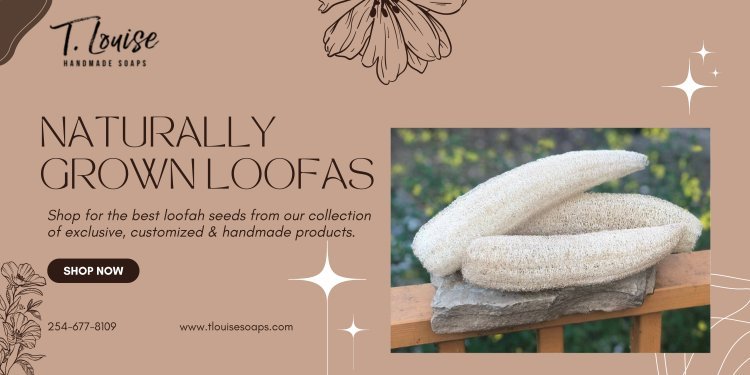The All-Natural Wonder: A Guide to Naturally Grown Loofas
This guide delves into the world of naturally grown loofas, exploring their origins, cultivation, benefits, and uses.

Loofahs, those wonderfully textured bath sponges, are a common household item. But have you ever wondered where they come from? Unlike their synthetic counterparts, natural loofahs are a sustainable and surprisingly versatile product derived from a fascinating plant. This guide delves into the world of naturally grown loofas, exploring their origins, cultivation, benefits, and uses.
From Vine to Sponge: The Loofah Plant
Loofahs also spelled luffa, are the fruit of the Luffa cylindrica or Luffa aegyptiaca plant, belonging to the Cucurbitaceous family. This places them as close relatives of familiar vegetables like cucumbers, melons, and squash. Native to tropical regions of Africa and Asia, loofah plants are vigorous climbers known for their long, vine-like growth.
The loofah fruit itself is a long, cylindrical gourd that develops a tough outer skin as it matures. Inside, a network of fibrous strands forms, which is the key component of the natural loofah sponge.
Growing Your Own Natural Loofah
Read more: Embrace Natural Beauty: The Allure of Coconut-Free Handmade Soap
For those interested in a sustainable approach to bath products, cultivating your loofah plants can be a rewarding experience. Here's what you need to know:
- Climate: Loofahs thrive in warm, sunny environments with long growing seasons. If you live in a temperate climate, starting seeds indoors before transplanting them outside is recommended.
- Planting: Loofah seeds are readily available online or at gardening stores. Sow them in fertile, well-draining soil after the risk of frost has passed.
- Support: As the vines grow, they require sturdy support structures like trellises or fences.
- Watering: Loofah plants need consistent moisture, especially during hot weather. Aim for deep watering several times a week.
- Harvesting: The ideal time to harvest loofahs is when the fruit turns brown and feels dry to the touch. The skin should easily peel away, revealing the fibrous network inside.
Tips: Loofahs can be susceptible to pests and diseases. Implementing organic pest control methods and practicing good garden hygiene are essential for a healthy crop.
Read more: The Alluring World of Natural Handmade Soaps: A Sustainable and Luxurious Choice
Benefits of Naturally Grown Loofas
Natural loofahs offer several advantages over their synthetic counterparts:
- Sustainability: Loofahs are a completely renewable resource. Once the sponge reaches the end of its lifespan, it can be composted, minimizing waste.
- Biodegradable: Unlike synthetic sponges that end up in landfills, natural loofahs decompose naturally, reducing environmental impact.
- Exfoliation: The fibrous texture of loofahs provides a gentle exfoliating effect, removing dead skin cells and promoting circulation.
- Hypoallergenic: Natural loofahs are a good option for those with sensitive skin, as they are less likely to irritate compared to some synthetic materials.
- Versatility: Beyond bath and shower use, loofahs can be repurposed for cleaning dishes, scrubbing surfaces, and even creating art projects.
Using and Maintaining Your Natural Loofah
Read more: Embrace Luxury and Sustainability with Handmade Soap Subscriptions
After harvesting and drying your loofah, it's ready for use. Here are some tips for maximizing its lifespan:
- Rinse and Dry Thoroughly: After each use, rinse your loofah with clean water and wring it out to remove excess moisture. Hang it to dry completely in a well-ventilated area to prevent mold growth.
- Cleaning: Periodically, you can deep clean your loofah by soaking it in a vinegar solution for 30 minutes. Rinse thoroughly and allow it to dry completely.
- Replacement: Like any sponge, natural loofahs will eventually need to be replaced. Typically, they last for 2-3 months with proper care.
Safety Note: Always inspect your loofah for signs of wear and tear before use. Discard it if the fibers become frayed or if mold growth develops.
Beyond the Bath: Exploring the Many Uses of Loofahs
Loofahs are incredibly versatile and can be repurposed for various tasks around the house:
- Natural Scouring Pad: The scratchy texture makes loofahs ideal for scrubbing pots, pans, and other hard surfaces.
- Garden Scrubber: Loofahs can be used to clean dirt and debris from gardening tools and equipment.
- Art and Craft Supplies: The dried fibers can be cut and shaped for various craft projects like doll hair or decorative elements.
- Pot Scrubbers: Cut loofah pieces into small squares to create natural pot scrubbers. These are gentle enough for delicate cookware.
By utilizing loofahs for these diverse purposes, you can further minimize waste and maximize the benefits of this sustainable plant-based product.
Source URL: https://bit.ly/3UJJx5N
What's Your Reaction?











![Wireless Connectivity Software Market Size, Share | Statistics [2032]](https://handyclassified.com/uploads/images/202404/image_100x75_661f3be896033.jpg)



